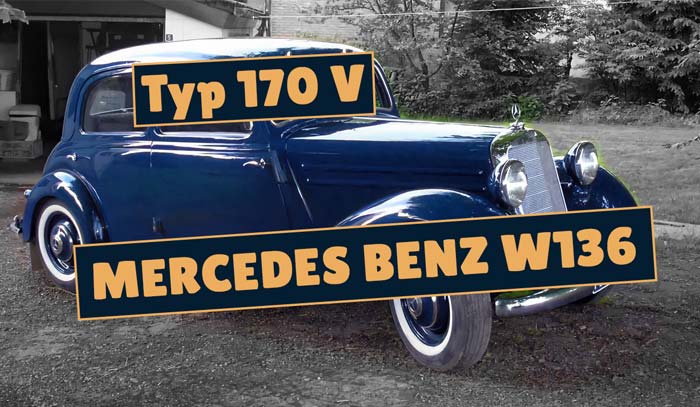Mercedes Benz 170V (W136) Origin
In 1936, the 1.7-liter four-cylinder rear-wheel-drive Mercedes-Benz 170 V (W136) was released to supersede the 1.7-liter six-cylinder Mercedes-Benz 170. (W15).
Cars from the Mercedes-Benz W136 series were Mercedes-primary Benz’s line of inline-four-cylinder automobiles from the mid-1930s through to the early 1950s. In February 1936, the W15 Typ 170’s successor, the type 170 V, made its public appearance. Mercedes’ best-selling car from 1936 through 1939 before it was succeeded by the Mercedes-Benz W120/121.
Now, grab a seat as I walk you through the outstanding qualities of what I believe to be the “Mercedes Cornerstone”. Meanwhile, subscribe and hit that bell icon so as not to miss any of our amazing videos.
Mercedes Benz 170V (W136) Overview
From the mid-1930s through the 1950s, the Mercedes-Benz W136 was the company’s principal series of inline-four-cylinder automobiles. In February 1936, the type 170 V made its first public appearance as the replacement for the W15 Typ 170. It was Mercedes’ best-selling vehicle from 1936 to 1939.
A sufficient number of the W136 components survived World War 2 to act as the cornerstone for the manufacturer’s rebuilding. By 1947, the Mercedes-Benz 170 V had reclaimed its position as Mercedes’ best-selling vehicle, a status it kept until 1953.
Even if its popularity reduced a bit in the late 1990s, there is no denying that the W136 is probably the most important piece in the history of the company for its role in the manufacturer’s development post World War 2.
Despite having equal engine capacity, the side-valve M136 in the updated automobile was more efficient. The manual gearbox had 4 synchromesh speed levels after it was upgraded in 1940. The maximum output was reported to be 38 PS (28 kilowatts; 37 horsepower) at 3,400 RPM with an initial compression ratio of six to one. The fuel consumption was 10 liters per 100 kilometers (24 miles per gallon). Come on, not that face, twenty-four miles per gallon was awesome 80 years ago.
The engine was mounted with only two fittings and served as the benchmark for every four-cylinder engine in vehicles.
The majority of vehicles built, and an even greater number of those that remain, were 2-or 4-door “limousine” (sedan or saloon) body styles, although the variety of alternative body types provided for the 170 V in the 1930s was extremely vast. Each door of the four-door variant was paired with something like a full-length collapsible canvas canopy in a four-door “Cabrio-Limousine.”
The four-door model is also available with huge baggage racks in the back, suited for taxi operations. There were two models: a 2-seater “Cabriolet A” that has two doors, and a 4-seater “Cabriolet B,” that also has two doors. Both models feature a baggage space behind the seat and underneath the bonnet storage position when collapsed.
Whether a two-door model, a four-door model, a Cabrio-limousine, a Cabriolet A, or Cabriolet B, there is something for almost everyone.
Mercedes Benz 170V (W136) Production
Over 75,000 were manufactured between 1936 to 1942, making it non-arguably the most renowned Mercedes-Benz design up to that date.
The Mercedes star was installed firmly on the grille for the first 2 years of manufacture, and the radiator cover was located beneath the hood. The grille was redesigned in 1937, and the star is now perched on the radiator cover. The pre-war output of W136 vehicles and light products was estimated to be over 90,000; manufacturing ceased in 1942 as resources were diverted toward WW2.
From 1938 through 1942, Mercedes-Benz produced approximately 19,000 pieces of the 170 V, which is an open-top vehicle for special forces. It is known as the 170 VK, which is the second-most manufactured German open combat vehicle of WW2.
Despite suffering serious damage during WW2, Mercedes-Benz recovered from the bomb damage of the war with a major competitive edge over some of its pre-war rivals.
Do you remember at the beginning of this video when I called the W136 the “Mercedes-Benz cornerstone?” The basis of brand’s recovery from the aftermath of World War 2 is based on the components of this amazing piece.
A more expensive and luxurious model known as the 170 S was developed in this period. Also, there was an upgraded version in 1950, 1952, and 1953, as well as a specialized model for police.
Mercedes Benz 170V (W136) Price
The 170V, like other older Mercedes Benz cars, was a wheeled exhibition of wealth and status. The V170, with body lines similar to the W15, went on to become a best-seller. This present day, the vintage car currently goes for around 155, 000 USD on certain online websites but there is no information regarding its price as of the time it was launched.


![Read more about the article Mercedes-Benz W08 – [Nürburg 460 Mercedes-Benz] – (1928 – 1939)](https://classicsdude.com/wp-content/uploads/2021/05/Mercedes-Benz-w08-website-300x174.jpg)
![Read more about the article Mercedes-Benz W11 [Stuttgart 260, 10/50 PS] – (1929 – 1034)](https://classicsdude.com/wp-content/uploads/2021/05/Mercedes-Benz-W11-website-300x174.jpg)
